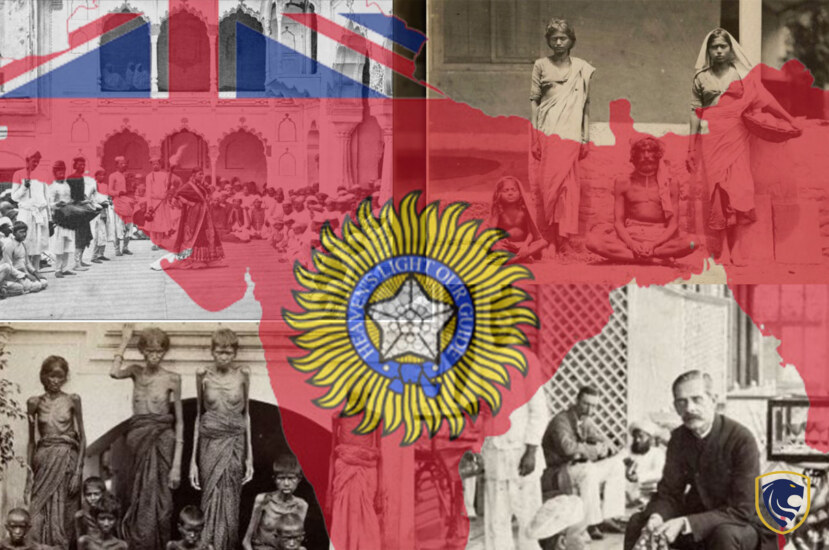In 1757, the Nawab of Bengal and his French allies were defeated in the ‘Battle of Plassey’ by the British East India Company. Thereupon Britain fortified its power over India. India was officially made a colony under the Queen Victoria of Britain in 1858 and remained a colony until India gained independence in 1947. There are arguments that India would be in a better economic position at the time it won independence if they were not colonized. And they claim India was richer before the British rule.
Vested Interests of British Rule
India was quite rich before the British rule and had a self-sufficient economy. The British rulers gave more importance to ‘cash crops’ instead of ‘growing crops’. Because they intended to proliferate their profits instead of feeding the masses. The British ushered in cash crops such as ‘Indigo, cotton, jute, tea, and tobacco’. India became a place where raw materials and food grains were produced and supplied to Britain.

Vested Interests of British Rule
The prosperity that the Indians enjoyed before British rule turned out to be austerity after the colonization. It is said that most of the Indians didn’t get proper nutritious meals. There are so many instances of famines that the Indians had to undergo. And the incidence of destitution was more prevalent. The blame was put on the British economic policies as the British rulers used land revenue for their good and wars in India and Europe, but not for the development of India.
Sorry State of Affairs during the Colonization
Numerous famines were recorded during the British rule. At the start of the 19th century, 7 devastating famines fell out. 15 lakhs of people died because of the famines. Towards the end of the 19th century, 24 famines occurred leading to the death of 200 lakhs of people. It is recorded that 3 to 4 million Indians lost their lives due to the Bengal famine which took place in 1943.
It is reported that the people who pulled through the Bengal famines took part in rebels of ‘Sanyasis’ and ‘Fakirs’. In fact, the Indians were forced to carry out multiple revolts in the face of injustice. They were obliged to pay unfair taxes, and they were ousted from their lands. On one occasion rebellious people refused to pay revenues to company agents. Later their protests were subdued. There are so many instances of revolts. The revolts of Poligars of Tamil Nadu, the Jats of western Uttar Pradesh, and the Haryana, Mappilas of Malabar are to name a few.

Sorry State of Affairs during the Colonization
The life expectancy of Indian people was one of the lowest in the world. People at large were illiterate.
Therefore, it is obvious that the Indians during British rule didn’t have good living standards. British rule was characterized by ruthless exploitation and their rule led to the devastation of India’s economy.
India’s Economy When the British left
When the British left India in 1947 India’s share of the world income was at 3%. In contrast, India’s share of the world income in 1700 AD, before the arrival of the British was at 27%. This leads to people think that India used to have a better economy before the colonization.

India’s Economy When the British left
Ancient India
The recorded history of India is more than 4000 years old, and it began with the Indu Valley civilization which lasted from 3500BC to 1800BC. In that period India was rich in terms of economy, infrastructure, engineering, and many other fields.
It is believed that the Indu Valley civilization‘s economy was centered around trade. There was an advanced transport system that aided trade activities. The citizens cultivated crops and reared domesticated animals. There is evidence that they made sharp tools and equipment out of copper, bronze, and tin.

Ancient India
Mesopotamia is a historic region located in West Asia. Ancient India had an excellent navigation system. There is proof that they made shipments to Mesopotamia, where they traded gold, copper, and jewelry. Punch-marked silver coins have been found, which were believed to be in use around 600 BC, during the excavations carried out. This era was bustled with trade activities and the urban development also took place in that era.
Mauryan Empire
The Mauryan empire which ruled India from 321 to 185BC united the whole of India. The internal peace, military security, and political unity that prevailed created a conducive environment for commerce and trade. Agriculture was the cornerstone of the Mauryan economy. The source of main state income was land revenue.

Mauryan Empire
Another feature of the empire was the improved infrastructure. They allocated a substantial amount of resources to constructing and maintaining roads throughout India. And coins had been used for trade.
The economy in the following years
In the years that followed India developed a long-established civilization that was rich. It was not only in terms of economy, but also India was advanced in the fields of education, art, architecture, and infrastructure.

The economy in the following years
India used to have a rich, opulent economy between the 1st and 17th century AD. During that period India had the richest and largest economy of the bygone world. India was believed to have controlled one-third and one-fourth of the total world’s riches from time to time in this era.
Mughal Empire
The Mughal period commenced in 1526AD and lasted till the conquest of India by the British in 1858AD. This period was prosperous more than ever before and had a flourishing economy. The 16th century was marked by the outstanding gross domestic product of India which accounted for 25.1% of the world economy and was considered the second largest in the world.

Mughal Empire
The difference between the pre-colonial economy and the economy during the British era is remarkable. In 1600AD the annual revenue of Emperor Akbar’s treasury was £17.5 million. But in 1800AD the entire treasury of Great Britain was £16 million. In 1700 AD Emperor Aurangzeb alone got an annual income of more than £100 million.
The Mughal emperor put in place a steady system of customs and tax administration. At the time Mughal Empire controlled 90 percent of South Asia.
Bright Side
Nevertheless, many positive aspects of colonization can be acknowledged. Some reforms of the British rule are humanistic. They abolished the ritual of sati where the widower jumped into the deceased husband’s funeral pyre. And infanticide was prohibited which was prevalent due to the dislike for the birth of girls. The widowers were ostracized and discriminated against. Under British law Hindu widows were allowed to remarry.

Bright Side of British colonization
Infrastructure too was developed greatly. Networks of roads, dams, and bridges were built. Also, irrigation, canals, and telephone/telegraph lines were developed under the British administration. It contributed to help India modernized. The areas such as public health and sanitation were improved too.
New schools and colleges were built. Both males and females got the opportunity to get an education. As a result, the literacy of people improved too.
Both the negative and positive effects of colonization can be cited.




